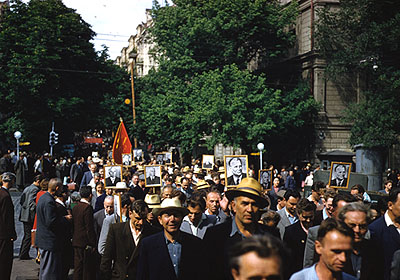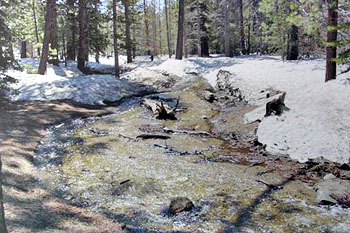Of
all things, a nice, peaceful political parade on a sunny day in Kiev
in 1958! See if you can find the photo of Khrushchev.
Photo by Thomas T. Hammond

The parade is a pretty good indicator of just how far the Soviet Union had moved politically in the five years since the death of Stalin. (And actually, when Khrushchev was removed from office in October 1964, the fact that he was peaceably pensioned off instead of being executed was a proud moment for him as he realized how much he had affected the course of Russian history.)
When he was removed from office in the "Little October Revolution," as some historians are fond of calling it, Pravda originally did not say much. The headline on 16 October 1964 read: "News Flash, Report from the Plenum of the Central Committee of the CPSU. On the 14th of October a plenum of the Central Committee took place. The Plenum--the Soviets tended to be a little repetitive--has granted the request of Khrushchev N. S. to be freed from the obligations of First Secretary of the CPSU, member of the Presidium of the Central Committee of the CPSU and Chairman of the Council of Ministers because of his advanced age and declining health. The Plenum of the Central Committee CPSU elected as First Secretary Comrade Brezhnev L. I." Three short official, "technical" announcements from these party and government bodies followed. Khrushchev then basically dropped out of any further mention in the Soviet press from that point onward, becoming, in essence, a non-person--The key was that he remained alive.
A few days later, an editorial in Pravda, 17 October 1964, "The Unshakable General Line of the CPSU," characterized Khrushchev's leadership in the following terms--buried deep in the editorial--as "hair-brained schemes, hasty conclusions and hurried, divorced-from-reality decisions, bragging and idle talk, an attraction to rule by fiat, unwillingness to take into account what science and practical experience have already discovered. The building of communism is a living, creative affair; it does not suffer clerical methods, individual decisions, or ignoring the practical experiences of the masses" (Pravda, 17 October 1964).
Look,
agriculture had long been a problem for the Soviet leaders; after all
communism was designed as a workers' ideology, and the Bolsheviks had
represented the workers (although speaking in the name of the peasants and soldiers)
in carrying out the revolution. Here are some figures to consider:
| US Population |
Russian Population |
Russian Wheat Production (million metric tons) |
US Wheat Production |
Russian Corn Production |
US Corn Production |
|
| 1897 |
125 million |
7 |
||||
| 1950 | 151 million | |||||
| 1959 |
208 million |
|||||
| 1960 | 180 million | |||||
| 1953 |
41 | 31 |
3.6 |
73 |
||
| 1964 |
74 | 35 |
13 |
88 |
Sources: www.fao.org/es/ess/historical/Default.aspx and B. R. Mitchell, European Historical Statistics, 1750-1975, 2nd rev. ed., (1980)
Agrogorods
In
the late 1940s, someone in the Soviet leadership had the crazy idea to
make farmers into workers. Let them live in small cities
(agrogorods) and go out to work in the fields, just as if they were
punching in at the local factory. The new "farmer-workers" were
to
have at their disposal mechanized fleets of tractors, and then return
home at night to enjoy the benefits of city life--Not to mention, it
was going to be easier for the communist party to keep tabs on the
farmers if they were living
in these little agrogorods. Khrushchev was put in charge of
carrying this out. Hundreds of small kolkhozes (collective farms)
were merged
into larger enterprises. Guess what? It just did not work.
Corn
Khrushchev rightly perceived that one of the major problems for the
Soviet Union was the lack of corn production. Corn, which in
addition
to being a very versatile human food, is absolutely crucial for
livestock production--if you want your citizens to eat meat, then you need
corn. You can look at the statistics above
which reveal that the USSR produced a minimal amount of corn.
Khrushchev said, "Let's produce more. How hard can it be?"
(Well, I'm paraphrasing a bit.) The idea of growing corn partly
accounted for
Khrushchev's fascination with the Iowan farmer Garst. (See Comrade Khrushchev and Farmer Garst: East-West Encounters
Foster Agricultural Exchange
by Stephen J. Frese) The problem was in the technical details,
determining exactly which variety of corn fit Russia's climatic
conditions and figuring out what special machinery would be
needed. Despite all the execution problems and the complaints
that Khrushchev had "corn on the brain," corn production did increase
under Khrushchev.
Virgin lands
Finally, the Virgin Lands
campaign was a huge undertaking championed by Khrushchev in 1954 as a
way of
quickly raising agricultural production in Russia. The theory was
that
there were vast tracts of steppe land available to be plowed up in
Central Asia, mainly Kazakhstan. Hundreds of thousands of
Russians and Ukrainians were induced to resettle to Central Asia and
take up farming there. This was a mass mobilization by the
party and Komsomol, trying to rekindle popular enthusiasm.
Between 1954 and
1955 something like between 70 and 80 million acres were plowed
under. The 1955 Russian harvest was rather disappointing,
and it did not look like all that effort had achieved anything, but
then 1956 brought a spectacular harvest with almost half of production
coming from the new areas, BUT, and this was a big "but," as with many
Soviet undertakings, the campaign had not been well thought out.
There
was no crop rotation done, no scientific work on how best to cultivate
the land, no measures taken to reduce soil erosion (an awful lot of
soil just blew away). The result was that by the early 1960s
production had dropped off in the Virgin Lands. (By the way, the Virgin
Lands campaign is why there is still such a large Russian population in
Kazakhstan today.).
So, these three examples were some of the "hair-brained schemes" of which Khrushchev stood accused. As you can see, all were interesting ideas; all probably doable, but, as they say, the devil is in the details.

Spring thaw; Photo courtesy Graham Owen.
- Ilya Ehrenburg, The Thaw (1955). See also his multi-volume Memoirs published in the 1960s.
- Carl A. Linden, Khrushchev and the Soviet Leadership, 1957-1964 (1966)
- Roy and Zhores Medvedev, Khrushchev: The Years in Power (1975)
- Hedrick Smith, The Russians (1976)
- Hedrick Smith, The New Russians (1990)
- Abram Tertz, The Trial Begins & On Socialist Realism (1960)
- Pavel Litvinov, The Demonstration in Pushkin Square (1969)
- Vladimir Dudintsev, Not by Bread Alone (1956)
- Nikita Khrushchev (1894-1971), Khrushchev Remembers (1970) and also Khrushchev Remembers: The Last Testament (1974) and Khrushchev Remembers: The Glasnost Tapes (1990)
- Andrei Voznesenskii, Selected Poems (1966)
- Nadezhda Mandelstam (1899-1980), Hope against Hope (1970)
- Milovan Djilas, The New Class: An Analysis of the Communist System (1957)
- Aleksandr Solzhenitsyn, The Gulag Archipelago (1973-76)
- Aleksandr Solzhenitsyn, August 1914 (1971)
- Aleksandr Solzhenitsyn, Cancer Ward (1968)
- Aleksandr Solzhenitsyn, The Oak and the Calf (1975). Read also his Nobel Prize in Literature 1970, nobelprize.org/literature/laureates/1970/solzhenitsyn-lecture.html
- George Breslauer, Khrushchev and Brezhnev as Leaders (1982)
- Karen Dawisha, The Kremlin and the Prague Spring (1984)
- Luba Brezhneva, The World I Left Behind (1995)
- Vasilii Grossman (1905-64), Life and Fate (1980)
- Anna Akhmatova, The Complete Poems (1990)
- Andrei Sakharov, Memoirs (1992)
- Remember, Russia had suffered an enormous amount of damage in World War II. It took a long time to recover. End of Rationing (1947)
- Khrushchev's Perceived failures
- Soviet Space Program, a Khrushchev Success?
- There was dissent; Andrei Sakharov
- Thaw in Literature
- Aleksandr Isaevich Solzhenitsyn
- Poetry of Joseph Brodsky
- Yevgeny Yevtushenko
- Babi Yar By Yevgeni Yevtushenko
- Thaw in film: Andrei Tarkovsky's Cinema of Spirituality
- The Guitar Poets
- Guitar poets real audio links (in Russian); also try Russian Songs
- Bulat Okudzhava
- There are a number of Vysotsky pages, on some of them you will find links to streaming audio of his songs: Vladimir Vysotsky Official Site (in Russian with other languages available); Vladimir Vysotsky in Different Tongues (in Russian with text of hundreds of songs and thousands of variants); Vysotsky in Theatre (selected video fragments in Russian); some video fragments of Vysotsky singing (not the greatest quality); image of Vysotsky's Grave.